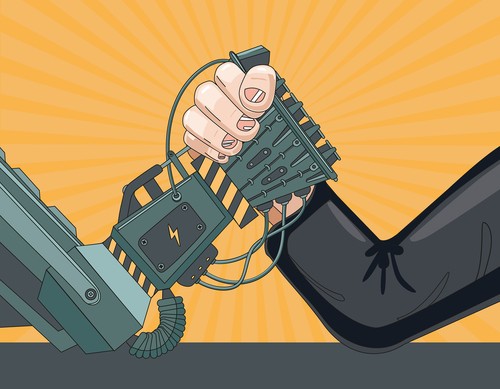Humans Vs Robots
admindarcy
12 September 2023

Q: What do Terminator, the Matrix and Blade Runner all have in common?
A: They’ve all got a dud (or in the case of the Matrix trilogy, several duds) in their respective canons, and their storylines are all based on a humans vs robots narrative.
This should come as no surprise. After all, history shows that we love the notion of pitting man vs machine. There‘s something perversely thrilling about the idea that the robots could (and probably will) take over at some point, and something equally chilling about the way in which the likes of ChatGPT has weaseled its way into the cultural narrative, put jobs at risk and shown that maybe the people calling for AI regulation have a point.
In short, we love a good humans vs robots narrative. And, when boiled down to its theological fundamentals, it’s not too distant from a tale of David vs Goliath, with the plucky humans hoping to land a pot-shot with their slingshot.

Unstoppable Force Meets Movable Object
The OG big vs small story is a rousing tale of the underdog using agility and guile to defeat a formidable, well equipped foe.
This is the point where it starts getting really interesting, and where this rambling stream of consciousness begins to take shape.
Because, when you think about it, the age-old struggle between man and machine has an awful lot of similarities with our industry’s current state of impasse, where publishers – the true creators of value in the advertising ecosystem – get pushed aside in the race to drive budget efficiencies for brands and advertisers.

Publishers = Out Muscled & Out Manoeuvred In The AdTech Arms Race
There is no doubt that advertisers play a crucial role in the ecosystem (it’s pretty hard to generate advertising revenue without advertisers after all), but… publishers are the ones that develop and host the content that attracts audiences.
Publishers are the ones powering the attention supply chain that makes digital advertising possible, and the ones working hardest to monitor and capture demand for content.
You’d think this would put them in pole position to acquire and deploy a vast array of technical resources, but the truth is very different and the access (to products, people and profit) is less than equal.
By comparison, the buy-side has amassed a huge arsenal of algorithmic warheads with suitably superlative names (case in point: IPG’s suite of ‘quantum-hybrid applications’) that drive ever increasing profits for brands and their platform providers.
(If this was a movie, it’d be called Buy Hard: With a Vengeance)

Buy Side Algorithms Do The Work, Whilst Publishers Actually ‘Do’ The Work
The wealth and power of the buy-side has kept the best technology out of the hands of the vast majority of publishers. The majority continue to rely on manual processes and overstretched (albeit highly capable) human teams – whilst platforms are given the luxury of re-investing their profits into product development, human capital and those complex pricing algorithms.
These algorithms make working out the probability of a (in the words of our founders in their past lives as buy side Dark-Siders) ‘downstream outcome’ as easy as… letting a pricing algorithm work out the best possible price for an RTB header auction whilst you embark on an afternoon of ‘deep work’ from your WFH desk station.

First Price Auctions = The Final Straw
Publishers on the other hand are finding it harder to sneak siestas between Zoom calls. There are many reasons for this, but the landmark event in the Crimes Against Publishers timeline is the introduction of first-price auctions in 2019 – a move which radically altered the bidding behavior of DSPs – allowing brands and their agencies to ramp-up their margins through sophisticated practices like bid-shading.
This brings us up to the present day, and makes it clear that the next installment in the long-running Humans (on the sell side) vs Robots (on the buy side) series is already here.
The robots have the upper hand. And publishers… don’t have a clear pathway to what happens next.
The Best Defense Is A Tech Powered Offense
People aren’t the problem, and parachuting executives over from the buy-side is definitely not the solution to mitigating the threat posed by the machines.
So, the only solution is to learn from history (and no, this isn’t our invitation to throw a Matrix Reloaded style doomsday rave to see in the end of publisher times) and channel our inner David vs Goliath. This means staying lean, remaining agile and… giving the robots a taste of their own algorithmic medicine when we see an opportunity to strike.
It’s also worth remembering that the real reason that people enjoy a David vs. Goliath story is that we always root for the underdog – if the underdog loses, a lot of the shine goes away! But the humble catapult is no longer a match for advanced technology, so any solution to this problem that doesn’t involve levelling the technological playing field is probably doomed to go straight to DVD at a Blockbuster no longer near you.

